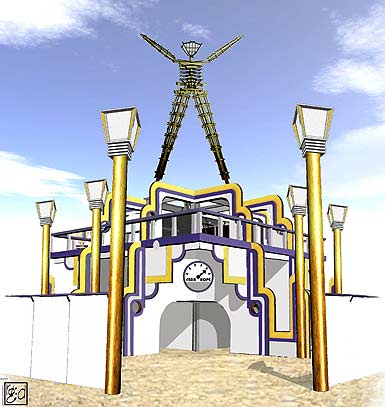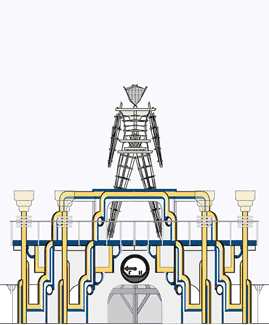


We take comfort in the notion that we have a past to guide us, but we reinterpret history every day according to what happens in the present. The future, too, is a projection of our hopes and fears in what is called the here and now. But even what we term the here and now is largely an imaginary place and time. If we say that now exists exactly now, we already speak of the past. We are caught in a temporal slipstream, a state of perpetual flux. The present really narrows down into the thinnest slice of time. It is no wider than the span of a reflexive arc, that moment when the heart says to the mind: so shall it be. This year’s art theme will allow us to explore how we create futurity. Express what you most hope for in the future! Express what you most fear! The Burning Man, as heartbeat of our city, will be made to rise and fall upon this tidal flow of our emotions and imagination.

The Pavilion of the Future / Design by Rod Garrett and Larry Harvey


The centerpiece of Hope and Fear will be a sleek Art Deco palace, the Pavilion of the Future. Art Deco, arising in the 1920’s and 30’s, became a symbol throughout much of 20th Century for all that was considered modern. Its streamlined and dynamic forms derived from an industrial aesthetic that romanticized progress. They summoned up a sense of power, purpose and velocity. As an art style, Deco stands as the West’s last commonly held vision of a utopian future. Today, of course, this art form represents a retro-future: one that never came to be. The principle problems of post-modern life do not concern how we’ll employ our endless leisure. Robots do not wait upon us hand and foot, nor do we jet from place to place in private rocket ships. Along the road to a utopia, these science fiction fantasies gave way to traffic jams. The future, it begins to seem, ran out of gas.

Within the Pavilion of the Future, participants will encounter a bewildering array of rooms arranged to form a maze. Each of these rooms will house art installations that are either utopic or dystopic. Utopias are visions of our highest hopes. They paint a picture of a better world. Dystopias are cautionary tales and correspond to fear of what the future has in store. Artists will also be invited to install various kinds of voting devices in the vestibule of the Pavilion. Some of these devices will depend on chance, like slot machines. Others will allow participants to directly express what they immediately feel. All will offer up a stark and simple choice: Will you vote for hope, or will you vote for fear? Further opportunities will be provided by elegant teeter-totters located in the circle that surrounds the Pavilion (a teeter signals green for hope; a totter signals red for fear). Voting booths will also be stationed at locations throughout Black Rock City.

Hope and Fear Contend / Illustration by Rod Garrett and Andrew Johnstone
All of these devices will be connected by a closed Wifi network, and linked to a secure computer equipped with a sophisticated software program. This futuristic technology will employ a complex algorithm to determine the statistical mean of our participating community’s hopes and fears at any given moment. As a result of these measurements, the Burning Man will either ascend while slowly raising its arms, as if to welcome all our hopes, or descend into a cage of fear located atop the Pavilion’s elevated deck. This latter movement will allow participants who win their way up to the deck to witness Burning Man close up through a chrome metal lattice constructed from the gleaming remnants of discarded auto parts. Will the Man remain mired in fear, or will he rise and stretch his arms against the sky? Amid urgent currents of hope and surging riptides of fear, the result is sure to be unpredictable. As with the rotating of the Man of 2005, this daily drama will occur only during evening hours.

Each of us is an emitter of the future, and hope and fear are both legitimate responses to the great unknown. Confronting fear, instead of fleeing it, requires courage and cool reason. This experience can lead to struggle and to change. Expressing what we hope for can inspire faith that opens up a path where none appeared before. In 2006, as the 21st Century rushes forward, the time has come to ask ourselves: Are we merely along for the ride? We encourage all participants to contribute to some aspect of this year’s art theme. Create a theme camp that forecasts the future. Imagine alternative pasts which, branching off from what we know, create alternative realities. Immediately confront your own future or the world’s future. Plunge into the time stream (and learn how to swim). If you are doing fire art or planning to install a work of art upon the open playa (whether it’s related to our theme or not), please see our Art Guidelines for more information. Any art by anyone is always welcome.

